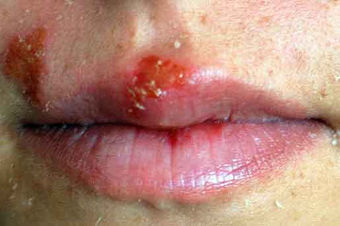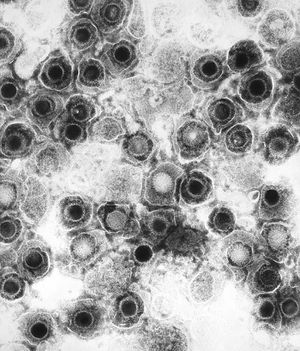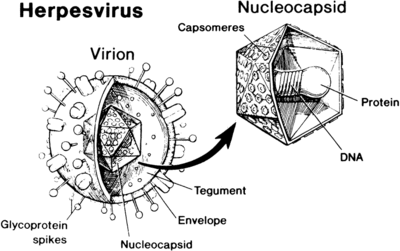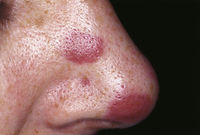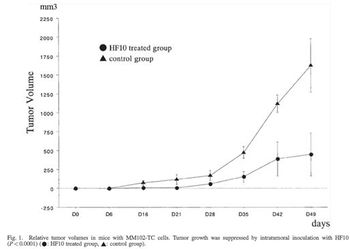Herpes Simplex Virus and Cancer
Herpes Simplex Virus 1, also known as oral herpes, is responsible for causing sores in the mouth and lip region when infected1. It can be spread by oral secretions such as kissing and sharing objects that have contact with saliva1. It is estimated that up to 90% of people in the United States have had contact with HSV-1 by the age of 502. The virus has the ability to lay dormant for some time in the nerve cells until it gets triggered again, forming somewhat painful lesions1 that last two to three weeks4. There is no cure for Herpes, however there are treatments that allow for the lessening of these lesions and pain that are typical of patients with the HSV virus1.
Kaposi sarcoma is a type of cancer that can be formed in the lining of the mouth, nose, throat and lymph nodes 3 and it characterized by purple or red spots on the skin5. It also has the ability to damage internal organs and cause breathlessness, bleeding gums, and stomach pains5. This rare cancer was found to be caused by the HSV virus, which is fairly common in the population, yet most people do not develop the cancer5.Kaposi sarcoma was very common in men of Middle Eastern descent but has now been shown to be common in AIDS patients3 and others who have weakened immune systems5. There are various ways to try to reduce the cancer, such as the common technique of chemotherapy and radiotherapy but the cancer may never be eliminated5.
Herpes Simplex Virus (HSV-1)
Understanding the molecular blueprint of HSV-1 is important in being able to accurately assess and understand the virus. This virus has been evolving since it was first discovered, creating two strains(HSV-1 and HSV-2). The molecular basis of the virus is given in order to understand the structure of the virus and what proteins are involved in its anatomy. Additionally, its means of replication is given to give further detail on everything there is to know about the virus in order to finally give ways that HSV-1 is being targeted.
Evolution of HSV-1
The Herpes Simplex 1 has evolved over time in different parts of the world, each being comprised of a different strain7. A phylogenetic tree conducted by gene sequencing revealed that there were six clades the herpes virus-1 can be categorized into based on geographic origin, one clade being form North America/Europe another from Asia and the other four being from Africa7. They each share a common ancestor at one point in time until they mutated as they made their way across the different areas of the world and faced selective pressures. It was also shown that the original strain of HSV came out of Africa and then diverged, with HSV-1 and HSV-2 diverging about 2.2. million years ago which corresponds to roughly the same time the genus homo was created7.
Molecular Basis of HSV-1
Understanding the structure of the virus is important in order to gain a full understanding of its molecular basis. HSV-1 is characterized by three distinct units: a capsid, an envelope, and proteins on its surface10, 11. Cryogenic microscopy was used to determine the capsid as well as how it interacts with the envelope to deliver its genome10. It was determined that the capsid consists of the outer shell, intermediate shell, and inner shell which all interact to eventually help form a pathway for the DNA from the virus to transfer to the host cell10. It was also found that the HSV-1 virus contains spikes on the outside of its surface in order to help facilitate the delivery of its genome and infect the host cell. Using immunoelectron microscopy, it was determined that these spikes contain certain glycoproteins(gB, gC, gD) which all aid in infectivity of the host cell11.
Replication of HSV-1
There are a plethora of protein to protein interactions that make up the Herpes Simplex Virus pathway. One of the key characteristics in the replication and formation of this virus is the presence of capsids which hold the viral genome and which are generated by the interaction of two proteins, pUL19 and pUL66. This is important to cause lysis of the host cell while keeping the viral genome intact6. A series of viral and cellular proteins are then combined to form a complex to create a proper environment for the virus to conduct primary envelopment and enter the inner nuclear membrane6. It then exits the nuclear membrane and the capsids undergo secondary envelopment which causes the mature herpes virus to emerge and spread throughput the body as an active virus6.
Combating HSV-1
Once the Herpes Virus enters the body, it is impossible to get rid of it8. As it enters the body, HSV-1 upregulates the expression of a protein, HIRRP, and also changes its location from the cytoplasm to the nucleus8. Interestingly, HIRRP was proven to inhibit HSV-1 replication and knocking down the HIRRP protein also proved to increase the efficiency of HSV-1 replication8. HIRRP blocks the transcriptional factor, ATF5 by binding to its N terminus and causing it to slow its rate of transcription8.
Kaposi Sarcoma
This cancer has been shown to affect the immune system and have a correlation with AIDS as well as the Herpes virus. Understanding the molecular basis of this cancer is important in being able to recognize how and why certain viruses can cause this cancer. Its means of replication as well as ways in which the cancer is being targeted are given to allows for a more comprehensive understanding of the cancer.
Molecular Basis of Kaposi Sarcoma
It has been shown that individuals that have Kaposi sarcoma have higher levels of antibody counts in their blood cells compared to those who do not have the cancer12. It is clear that the immune system plays a role in the formation of cancerous tumors, specifically four immune mediators(CXCL10, sIL-1RII, sIL-2RA, CCL3)12. In this study, it was shown that those who had elevated levels of CXCL10 were 8 times more likley to develop cancerous tumors, Kaposi sarcoma. The rest of the immune mediators were shown to have some sort effect on KS such as sIL-2RA's ability to activate with increased B and T cell activation12. This supports the idea that patients with Kaposi sarcoma have higher antibody levels, and thus higher levels of sIL-2RA. The control samples did not have any indication of Kaposi sarcoma and thus had normal levels of the four immune mediators12. Therefore, this study was able to show that patients with Kaposi sarcoma had elevated levels of these four immune mediators, which can have a correlation in discovering the treatment for this cancer.
Combating Kaposi Sarcoma
There have been multiple studies that have been done to try and discover an ailment to Kaposi sarcoma. One such research that was done in a clinical setting was using Beta-Ara to determine if it would suppress tumor growth13. The exact Beta receptor is known as Timolol, and it functions by telling endothelial cells to commit apoptosis, which would hinder Kaposi sarcoma in theory13. Timolol was tested in two cases, one of a man who had developed KS in his foot and another of a woman who had the cancer on her right foot. This was administered via an ointment which was applied, and after twelve weeks the tumors in both patients showed substantial reduction13. After over a year and a half, there was still no sign of regrowth of the tumor, proving that this Beta receptor, timolol, was able to suppress tumor growth13. However, this study is still in the preliminary states and need to be tested in many more patients for it to be valid and used for mass production.
HSV-1 as a Mechanism to Stop Kaposi Sarcoma
An interesting topic that is being studied is the use of viruses to infiltrate a cancerous cell and destroy it by lysing it9. A copy of HSV-1 that contained a mutation, known as HF10, was tested out to determine if it would deter the rate of tumorous cells in breast cancer9. It was found that the HS10 was capable of reducing the amount of cancerous tumors and the rate at which they grew. In all of the cell lines that were tested, the mutant HSV-1 virus was able to suppress growth9.
This is very interesting because it leads to an entirely new topic of whether HSV-1 can actually be used to defeat cancer rather than cause it. If it can be proven to deter the effects of breast cancer, it may be able to help deter other cancers as well.
Further Reading
An interesting follow up to this topic would be to look into further studies that promote Kaposi Sarcoma. One such study looks into organ transplants and how that can put patients at an increased risk of developing this cancer14. Organ transplant patients that were composed of both children and adults were tested for the presence of proteins that encode for Kaposi Sarcoma after 6-7 months14. The results were the same, despite the change in a persons age or gender, showing that Kaposi sarcoma may not be solely transmitted through sexual contact14. The results from this study gave evidence that the cancer may be spread via blood to blood contact rather than just sexual contact14.
References
1. Johnson, Traci. "Herpes Simplex: Herpes Type 1 and 2." Genetial Herpes Health Center. Web MD. Web.
2. "Mouth Infections." Health Library. Johns Hopkins Medicine. Web.
3. Derrer, David. "HIV, AIDS, and Kaposi Sarcoma." HIV & AIDS Health Center. Web MD. Web.
5. "Kaposi's Sarcoma." NHS Choices. Web.
Edited by Alejandro Zuniga, a student of Nora Sullivan in BIOL168L (Microbiology) in The Keck Science Department of the Claremont Colleges Spring 2015.
